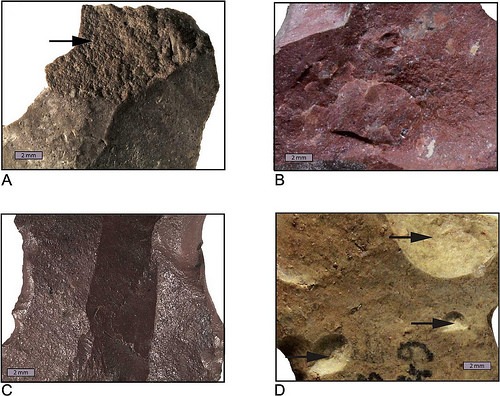
PLOS—Humans living in South Africa in the Middle Stone Age may have used advanced heating techniques to produce silcrete blades, according to a study published October 19, 2016 in the open-access journal PLOS ONE by Anne Delagnes from the CNRS (PACEA – University of Bordeaux, France) and colleagues.
Middle Stone Age humans in South Africa developed intentional heat treatment of silcrete rock over 70,000 years ago to facilitate the flaking process by modifying the rock properties – the first evidence of a transformative technology. However, the exact role of this important development in the Middle Stone Age technological repertoire was not previously clear. Delagnes and colleagues addressed this issue by using a novel non-destructive approach to analyze the heating technique used in the production of silcrete artifacts at Klipdrift Shelter, a recently discovered Middle Stone Age site located on the southern Cape of South Africa, including unheated and heat-treated comparable silcrete samples from 31 locations around the site.
_____________________________________
Humans living in South Africa in the Middle Stone Age may have used advanced heating techniques to produce silcrete blades, according to a study published Oct. 19, 2016 in the open-access journal PLOS ONE by Anne Delagnes from the CNRS (PACEA – University of Bordeaux, France) and colleagues. Credit: Delagnes et al (2016)
__________________________________________________
The authors noted intentional and extensive heat treatment of over 90% of the silcrete, highlighting the important role this played in silcrete blade production. The heating step appeared to occur early during the blade production process, at an early reduction stage where stone was flaked away to shape the silcrete core. The hardening, toughening effect of the heating step would therefore have impacted all subsequent stages of silcrete tool production and use.
The authors suggest that silcrete heat treatment at the Klipdrift Shelter may provide the first direct evidence of the intentional and extensive use of fire applied to a whole lithic chain of production. Along with other fire-based activities, intentional heat treatment was a major asset for Middle Stone Age humans in southern Africa, and has no known contemporaneous equivalent elsewhere.
Source: PLOS press release
__________________________________________________
*Delagnes A, Schmidt P, Douze K, Wurz S, Bellot-Gurlet L, Conard NJ, et al. (2016) Early Evidence for the Extensive Heat Treatment of Silcrete in the Howiesons Poort at Klipdrift Shelter (Layer PBD, 65 ka), South Africa. PLoS ONE 11(10): e0163874. doi:10.1371/journal.pone.0163874
_________________________________________________

______________________________________________
Travel and learn with Far Horizons.
____________________________________________
This richly illustrated issue includes the following stories: Recent findings shedding new light on the whereabouts of the remains of Philip of Macedon, father of Alexander the Great; how an archaeologist-sculptor is bringing bones of the dead back to life; archaeologists uncovering town life at the dawn of civilization; an exclusive interview with internationally acclaimed archaeologist James M. Adovasio about what makes the Meadowcroft Rockshelter prominent in the ongoing search for the first Americans; what archaeologists are finding at the site of the ancient city of Gath, the home town of the biblical Philistine giant, Goliath; and how scientists are redrawing the picture of human evolution in Europe. Find it on Amazon.com.







